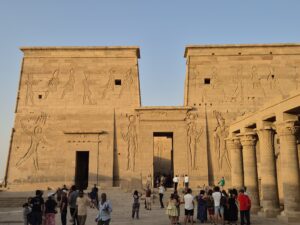Introduction
Egypt is a dream destination: the sheer size of the Pyramids of Giza, the calm of a Dahabiyat on the Nile, the vibrant colors of Luxor’s temples… But let’s be honest, as soon as you land in Cairo, a practical worry often pops up: “How am I going to get internet without racking up a huge phone bill?”
Between the endless lines at airport kiosks to buy a local SIM card and the panic of turning on mobile data (and getting a hefty bill from your home carrier), there is now a much simpler solution: the eSIM.
Our simpleSIM team just returned from a trip to Egypt. Here is why it’s the essential accessory for your trip, whether you are traveling with family, friends, or for business.
Why Egypt Requires Constant Connection
Egypt isn’t a destination where you want to be offline. And it’s not just because we can’t resist posting Instagram stories (even though that’s important!). Having data in Egypt is primarily a matter of comfort and safety.
During our trip, our eSIM saved the day more than once:
- Getting around Cairo: Traffic is dense and chaotic. Accessing Uber or Careem is vital for safe travel at a fixed price.
- Instant Translation: Signs and menus aren’t always in English. A quick use of Google Lens, and hieroglyphs (or modern Arabic) become understandable.
- Guides in Your Pocket: Standing in front of the Sphinx or in the Valley of the Kings, having access to Wikipedia or online audio guides significantly enriches the visit.
“It Works Here Too”: The Real-Life Team Test
Many travelers worry that network coverage might be spotty in the desert or on the river. We wanted to find out for sure.
We activated our simpleSIM Egypt profiles right before departure. Here is our verdict from the field:
1. At the Foot of the Pyramids (Giza)
This is the ultimate crash test. In the middle of the Giza Plateau, facing 4,500 years of history, the 5G signal was perfect. Sharing this moment via FaceTime with family back home? No problem at all.

2. Cruising the Nile
We often assume that signal disappears on the water. Wrong. Between Luxor and Aswan, the Nile is very well covered. It’s the perfect time to sort through your photos, answer a few work emails, or check the next day’s itinerary, comfortably settled on the cushions of the upper deck.

3. In the Temples (Philae, Karnak)
Even in more remote sites like the magnificent Temple of Philae (accessible only by boat), the connection remains stable.

eSIM vs. Local SIM: The Showdown
Still hesitating to buy a local card at the airport? Here is why the eSIM wins for modern travelers:
- Time Saver: No need to queue at the Vodafone or Orange counter upon arrival (when you’re already tired from the flight). You install your eSIM from your couch before leaving, and you know you’ll be connected the moment you switch off Airplane Mode upon landing.
- Convenience: Your domestic SIM (or eSIM) stays in your phone. No need for a paperclip to take it out or worry about losing it. You keep your home number and remain reachable in case of emergency. WhatsApp works with your usual number while using the eSIM data.
- Hotspot Sharing: Traveling in a group or as a couple? Our eSIMs allow tethering (hotspot). A single eSIM can get the kids or friends online.
How to Install Your eSIM for Egypt?
It’s easier than assembling IKEA furniture.
- Choose your plan on our Egypt page.
- Receive your QR code by email immediately.
- Scan it (ideally before boarding your flight).
- Once you land on Egyptian soil, turn on “Data Roaming” for the eSIM line. That’s it!
Conclusion
Egypt is an unforgettable adventure, a deep dive into human history. Don’t let technical issues spoil the experience. With an eSIM, you enjoy the best of both worlds: total escape and the security of being connected whenever you need to be.
Ready to go? 👉 Discover our eSIM offers for Egypt starting at just a few euros.
